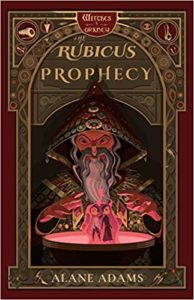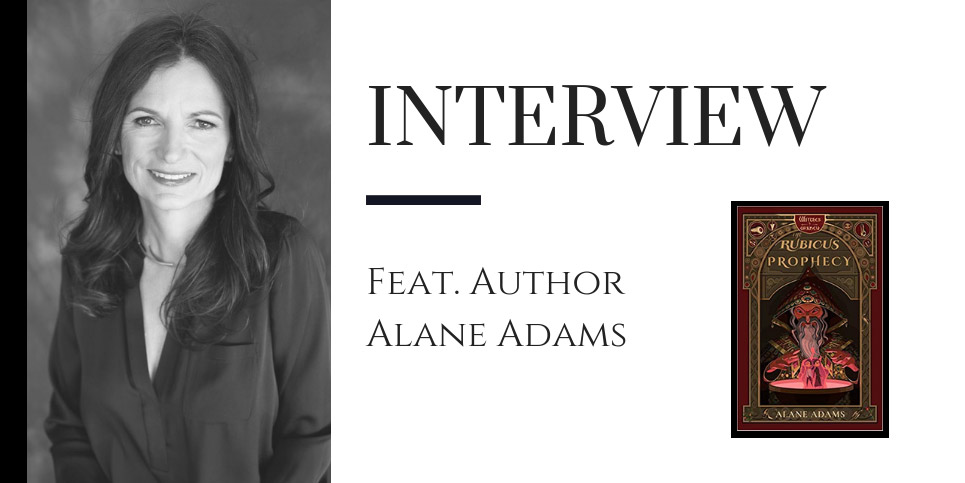Author Showcase
Sponsored*
The Children’s Book Review | August 30, 2019
Alane Adams is an author, professor, and literacy advocate. She is the author of the Legends of Orkney fantasy mythology series for tweens and The Coal Thief, The Egg Thief, The Santa Thief, and The Circus Thief picture books for early-grade readers. Here we discuss her latest book series Witches of Orkney.
The Children’s Book Review: The Rubicus Prophecy is the second installment in your Witches of Orkney series. As it is a series that delves deeper into the lives of characters from your Legends of Orkney fantasy mythology series, would you recommend reading the original series first?
Alane Adams: The series are designed to be read in any order. There is fun in going back and seeing the older characters from the first series who were adults, now the main characters as kids. And it’s fun to see what happens to those characters when they grow up. The tricky part is to make sure a major plot point isn’t revealed that might spoil a reader’s enjoyment of one of the books.
There are many characters and regions in your fantasy realm. When writing the books, what is your process for keeping track of the characters and their traits to maintain continuity?
It’s definitely not easy. I have to go back and search occasionally to find what someone’s eye color was. Their personality traits are easier because your characters are kind of like your friends-as you’re writing about them you get to know them and they develop their own personalities and voices. I will create spreadsheets when I’m starting something new to keep track of names, made-up words, and unique physical traits, but once I’m in the swing of the story, or further into a series, it really comes pretty easily.
What inspired you to branch into this new series that focuses on the witches? Was there a specific character or event that spurred you on?
As a literacy advocate, I travel the country visiting elementary schools and talk to kids about reading and the writing process. I felt there was a gap in the books I had available for the kids to read. They’re so excited when they meet an author it encourages them to want to read, but so many of those 3rd and 4th graders really weren’t ready for the Legends of Orkney series, but they had outgrown picture books.
In the first series, my main character’s mom is a witch, only instead of having green witchfire, hers is blue. I mention this a couple of times throughout the series, but I had never really considered why that was—it was always an open question in my mind. So when I came up with the idea of writing a prequel series, that was the first question I wanted to answer!
There is a map in the beginning pages of The Rubicus Prophecy. Does the map also aid you in your writing to keep track of the setting?
Maps are so helpful in visualizing the world you are trying to create! I literally hand draw a map when I start imagining a world so I can keep track of where the characters are going, how far away a place is, and how long it would take them to get there. No pun intended, but I would be lost without a map.
The series immerses readers into both mythology and fantasy. Have you always been fascinated by these genres?
I grew up reading voraciously, everything from Zane Grey westerns, Robert Heinlein science fiction, and the most memorable, Tolkien’s Lord of the Rings trilogy. Fantasy has the highest rank in my books as favorite genre to read. The mythology aspect really came in when my son asked me to write these books. He was a huge fan of other mythology series, and once I began researching it, I realized how much fun was to be had adapting these mythological characters and stories to fit in with your own. There’s a reason these myths have endured as long as they have and continue to be so popular because having familiar characters with enormous powers and a well-known history makes it a fun combination.
What made you decide to bring both genres together?
I think it was the mashup of my favorite genre being fantasy and my son’s favorite genre being mythology. I was able to use some of the Norse narrative and gods but the main focus in the story is really on the main character’s journey and adventures. The mythology is more of a backdrop and provides some of the world structure, but doesn’t overwhelm the story.
They say to be a writer you must first be a reader. Do you agree with this? And, if so, which of the books that you have read do you believe made you a writer?
This is absolutely true. It’s why football players spend so much time watching tapes of football. The only way to understand intuitively how something works—in this case story arc, character development, world building, and the element of suspense—is to know it inside and out. What better way to learn then to read a lot of stories? Also, reading is one of the most powerful ways to trigger and grow your imagination because the entire story is taking place in your head. You imagine things you’ve never seen before, go places you’ve never been, and learn problem solving by following characters on their journey. I think one of the most impactful series I ever read was the Dune series by Frank Herbert. It was such a fantastical world and the main character gripped me from the first page.
What has been the best writing advice you have ever received?
Writing is rewriting. I think most authors starting out don’t realize this enough. We think when we finish a manuscript and are basking in that glow, that the hard part is over, when in fact its just begun. I spend more time revising what I’ve done than I have creating it, always wishing I could have gotten it right the first time, but now understanding that it’s not how it works. Getting something out of the crevasses of your brain and onto the page is one step. The next is to hone it and craft it into something worthy. You cannot excavate, hone, and craft at the same time. At least I can’t!
If you could sum up your life, so far, in a book title, what would that title be?
Mistakes Were Made.
I like this title because it’s sort of indicative of the path I’ve taken to get where I am. I wish I could go back and convince my younger self to have believed enough in my writing skills to pursue that path early on. I tried many times over the years to turn to my writing and never had the courage to stick with it until my son challenged me to write him a book. Nonetheless, I am glad to be here now!
Is there anything else you would like to share about your books, your writing, or yourself?
I feel so fortunate to have finally aligned all the passions in my life into one coherent focus. Being a children’s literacy advocate and author allows me to do the things I love the most, create an impact, and hopefully, put a smile on a child’s face.
—
 The Rubicus Prophecy: Witches of Orkney: Book Two
The Rubicus Prophecy: Witches of Orkney: Book Two
Written by Alane Adams
Illustrated by Jonathan Stroh
Publisher’s Synopsis: Abigail has just started her second year at the Tarkana Witch Academy and is already up to her ears studying for Horrid Hexes and Awful Alchemy! Worse, Endera’s malevolent spellbook has its hooks in her, whispering in her ear to use its dark magic. Meanwhile, the entire school is talking about the Rubicus Prophecy; a sign has arrived that the chosen witchling is among them, the one who will one day break Odin’s curse over them. When an Orkadian warship arrives carrying troubling news, Abigail and her friend Hugo are swept into a new mystery after a young boy from the ship, Robert Barconian, asks for their help retrieving a missing item.
“The Rubicus Prophecy: Witches of Orkney: Book Two is a fast read that will likely appeal to fans of Harry Potter or the Septimus Heap series.” — The Children’s Book Review
Ages 8-12 | Publisher: SparkPress | October 15, 2019 | ISBN-13: 978-1943006984
Buy the Book
Learn More
AlaneAdams.com | Facebook | Twitter | Instagram | Alane’s Literacy Foundation
The Author Showcase is a place for authors and illustrators to gain visibility for their works. Alane Adams Discusses the Witches of Orkney is a sponsored* interview. Discover more great writing and illustrating artists in our Showcase.

